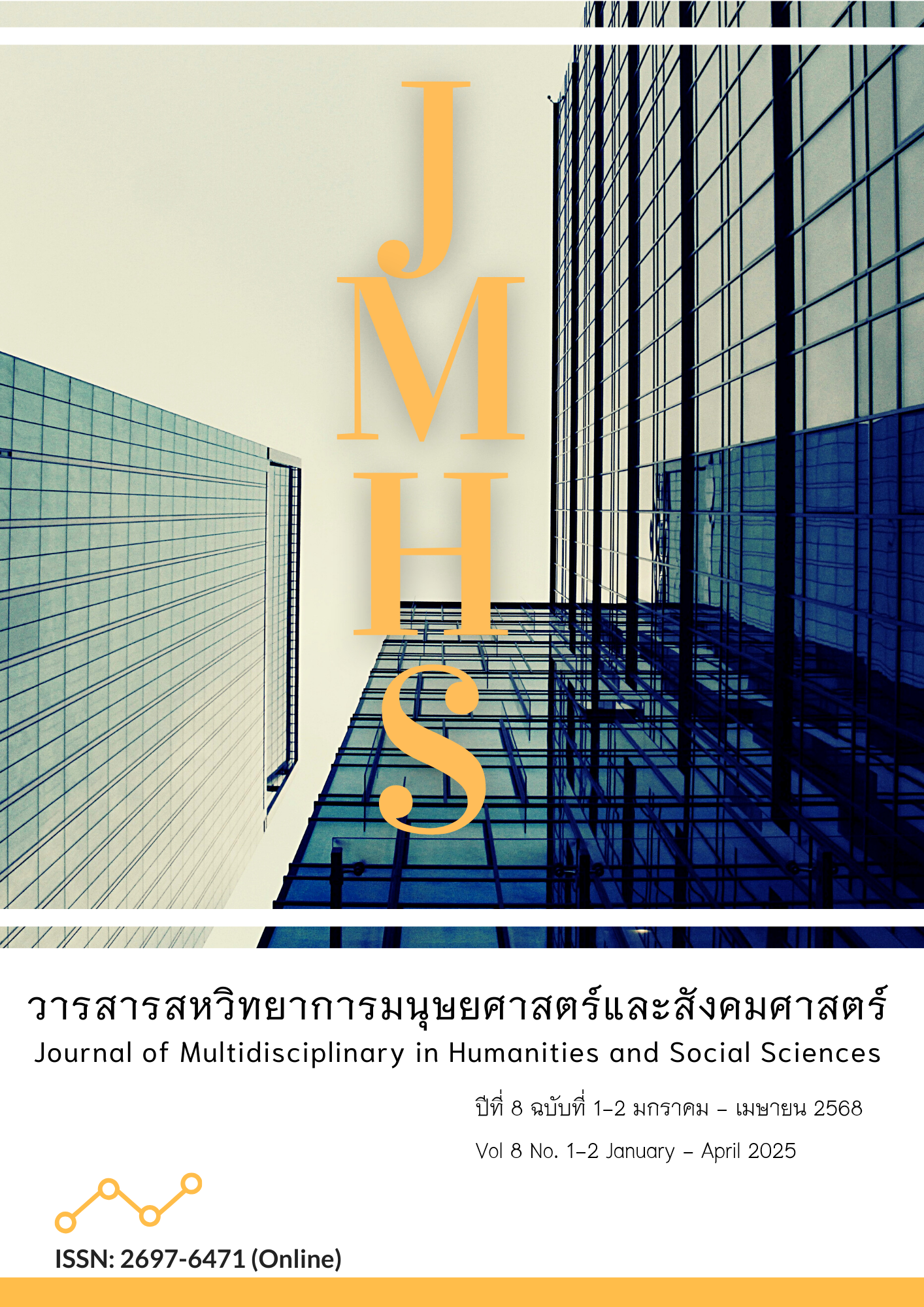ปัจจัยเชิงสาเหตุที่มีอิทธิพลต่อการบอกแบบปากต่อปากบนเพจเฟซบุ๊กของผู้บริโภค ในกรุงเทพมหานครและปริมณฑล
Main Article Content
บทคัดย่อ
การสื่อสารการตลาดมีบทบาทสำคัญในการกระตุ้นการตัดสินใจซื้อของผู้บริโภค โดยเฉพาะในยุคที่โซเชียลมีเดียเป็นช่องทางหลักในการค้นหาข้อมูลและแลกเปลี่ยนความคิดเห็นเกี่ยวกับสินค้าและบริการ บทความวิจัยนี้มีวัตถุประสงค์เพื่อ 1) พัฒนาและตรวจสอบความสอดคล้องของโมเดลความสัมพันธ์เชิงสาเหตุการบอกแบบปากต่อปากทางอิเล็กทรอนิกส์บนเพจเฟซบุ๊กของผู้บริโภค ในกรุงเทพมหานครและปริมณฑลและ 2) ศึกษาปัจจัยเชิงสาเหตุที่มีอิทธิพลต่อการบอกแบบปากต่อปากทางอิเล็กทรอนิกส์บนเพจเฟซบุ๊กของผู้บริโภคในกรุงเทพมหานครและปริมณฑล รูปแบบการวิจัยเป็นการวิจัยเชิงปริมาณ เครื่องมือที่ใช้เก็บรวบรวมข้อมูล ได้แก่ แบบสอบถามออนไลน์ กลุ่มตัวอย่าง คือผู้ที่เคยซื้อผลิตภัณฑ์แม่และเด็กบนเพจเฟซบุ๊กและพักอาศัยในกรุงเทพมหานครและปริมณฑล จำนวน 447 คน สถิติที่ใช้วิเคราะห์ข้อมูล ได้แก่ ความถี่ ร้อยละ การวิเคราะห์องค์ประกอบเชิงยืนยัน และโมเดลสมการโครงสร้าง ผลการวิจัยพบว่า โมเดลความสัมพันธ์เชิงสาเหตุที่พัฒนาขึ้น ประกอบด้วย 4 ด้าน ได้แก่ 1) ด้านคุณภาพการบริการ 2) ด้านความไว้วางใจ 3) ด้านความพึงพอใจ และ 4) ด้านการบอกแบบปากต่อปากทางอิเล็กทรอนิกส์ สอดคล้องกับข้อมูลเชิงประจักษ์เป็นอย่างดี ด้านคุณภาพการบริการ ด้านความไว้วางใจ และด้านความพึงพอใจ มีอิทธิพลต่อการบอกแบบปากต่อปากทางอิเล็กทรอนิกส์ของผู้บริโภคตามลำดับ ซึ่งผู้ประกอบการธุรกิจควรคำนึงถึงคุณภาพความไว้วางใจและความพึงพอใจเป็นสำคัญเพื่อให้เกิดการบอกแบบปากต่อปากกลับมาซื้อผลิตภัณฑ์อีกครั้ง
Article Details

อนุญาตภายใต้เงื่อนไข Creative Commons Attribution-NonCommercial-NoDerivatives 4.0 International License.
ทัศนะและความคิดเห็นที่ปรากฏในวารสาร ถือเป็นความรับผิดชอบของผู้เขียนบทความนั้น และไม่ถือเป็นทัศนะและความรับผิดชอบของกองบรรณาธิการ
เอกสารอ้างอิง
กัณฐิกา จิตติจรุงลาภ. (2562). การสื่อสารแบบปากต่อปากอิเล็กทรอนิกส์ต่อพฤติกรรมการซื้อสินค้าออนไลน์. วารสารระบบสารสนเทศด้านธุรกิจ, 5(2), 43-95. สืบค้นจาก https://jisb.tbs.tu.ac.th/wp-content/uploads/2022/10/3Kantika_N.pdf
คงสหสรรค์ นันดิลก และ สมชาย เล็กเจริญ. (2566). ปัจจัยเชิงสาเหตุที่มีอิทธิพลต่อความตั้งใจซื้อเครื่องสําอางผ่านแอปพลิเคชันติ๊กต็อกในประเทศไทย. วารสารสหวิทยาการมนุษยศาสตร์และสังคมศาสตร์, 6(3), 1489-1507. สืบค้นจาก https://so04.tci-thaijo.org/index.php/jmhs1_s/article/view/264534/179612
ณฐกร ตระการศักดิกุล, สุริย์วิภา ไชยพันธุ์ และ เบ็ญจวรรณ ลี้เจริญ. (2565). อิทธิพลของคุณภาพการบริการอิเล็กทรอนิกส์ในฐานะตัวแปรคั่นกลางโมเดลความสัมพันธ์เชิงสาเหตุของการตัดสินใจซื้อหนังสืออิเล็กทรอนิกส์ของผู้บริโภคในประเทศไทย. สหวิทยาการและความยั่งยืนปริทรรศน์ไทย, 11(2), 209–224. สืบค้นจาก https://so03.tci-thaijo.org/index.php/JIRGS/article/view/263942
ณรงค์ศักดิ์ ห่วงมาก และ สมชาย เล็กเจริญ. (2566). ปัจจัยเชิงสาเหตุที่มีอิทธิพลต่อการบอกต่อแบบปากต่อปากในการใช้บริการถ่ายภาพบนเพจเฟซบุ๊กของผู้บริโภคในกรุงเทพมหานครและปริมณฑล. วารสารสหวิทยาการมนุษยศาสตร์และสังคมศาสตร์, 6(3), 1456–1473. สืบค้น
จาก https://so04.tci-thaijo.org/index.php/jmhs1_s/article/view/264214
ธัมมะทินนา ศรีสุพรรณ. (2563). อิทธิพลด้านความบันเทิง ความไว้วางใจ และความเพลิดเพลินกับการสื่อสารแบบปากต่อปากทางอิเล็กทรอนิกส์ของลูกค้าในธุรกิจโรงแรม. วารสารวิทยาการจัดการมหาวิทยาลัยราชภัฏพิบูลสงคราม, 2(1), 66–78. สืบค้นจาก https://so03.tci-thaijo.org/index.php/jmspsru/article/view/244097
นงลักษณ์ วิรัชชัย. (2542). โมเดลลิสเรล: สถิติวิเคราะห์สำหรับการวิจัย. (พิมพ์ครั้งที่ 3). กรุงเทพฯ: โรงพิมพ์แห่งจุฬาลงกรณ์มหาวิทยาลัย.
นันทวุฒิ เถาถวิล และ สุชัญญา สายชนะ. (2566). คุณภาพการให้บริการที่ส่งผลต่อความพึงพอใจของผู้รับบริการศูนย์รังสีรักษาและมะเร็งวิทยา โรงพยาบาลธรรมศาสตร์เฉลิมพระเกียรติ. ใน 25th National Graduate Conference, 3 July 2023 (pp. 1-10). Sripatum University, Thailand. สืบค้นจาก https://so09.tci-thaijo.org/index.php/PMR/article/view/2774/1623
ปภัสสา ศักดิ์ศิริกุล. (2563). อิทธิพลของการสื่อสารแบบปากต่อปาก (WOM) บนสื่อสังคมออนไลน์และความไว้วางใจที่มีผลต่อความตั้งใจท่องเที่ยวในประเทศไทยในยุคโควิด-19 ระลอก 3 ของประชาชนในเขตกรุงเทพมหานคร. วารสาร มจร อุบลปริทรรศน์, 6(3), 585-598. สืบค้นจาก https://so06.tci-thaijo.org/index.php/mcjou/article/view/252665/171787
ปภาภรณ์ ธนะเรืองสกุลไทย และ บุหงา ชัยสุวรรณ. (2566). ปัจจัยพยากรณ์การซื้อสินค้าแบบทันทีทันใดและการสื่อสารแบบปากต่อปากอิเล็กทรอนิกส์ของอินสตาแกรมคอมเมิร์ซ. วารสารนิเทศศาสตร์และนวัตกรรม นิด้า, 10(1), 77-101. สืบค้นจาก https://so02.tci-thaijo.org/index.php/jcin/article/view/261191/177672
ผ่องใส สินธุสกุล, พงษ์สันติ์ ตันหยง และ พิชามญชุ์ เลิศวัฒนพรชัย. (2566). ปัจจัยที่มีอิทธิพลต่อการบอกต่อแบบปากต่อปากของผู้บริโภคสินค้าออนไลน์ในประเทศไทย. วารสารสหวิทยาการมนุษยศาสตร์และสังคมศาสตร์, 6(3), 1549–1565. สืบค้นจาก
https://so04.tci-thaijo.org/index.php/jmhs1_s/article/view/264823/179616
รัตนไชย สิงห์ตระหง่าน และ สุมาลี รามนัฏ. (2566). อิทธิพลของส่วนประสมทางการตลาด ความไว้วางใจ และความพึงพอใจต่อการตัดสินใจซื้อสินค้าแฟชั่นด้วยระบบออนไลน์. Kasem Bundit Journal, 24(1), 33-46. สืบค้นจาก https://so04.tci-thaijo.org/index.php/jkbu/article/view/250077
ศนิวาร วัฒนานนท์ และ ประพล เปรมทองสุข. (2566). อิทธิพลของการสื่อสารแบบปากต่อปากทางอิเล็กทรอนิกส์ที่มีผลต่อ การรับรู้แบรนด์ คุณภาพที่รับรู้ และความตั้งใจซื้อสินค้าเครื่องสำอางของลูกค้าในเขตกรุงเทพมหานคร. วารสารนวัตกรรมการจัดการศึกษาและการวิจัย, 6(4), 793–806. สืบค้นจาก https://so02.tci-thaijo.org/index.php/jemri/article/view/271492
สมชาย เล็กเจริญ และ ชุติธารรัฐ อุตมะสิริเสนี. (2565). ปัจจัยเชิงสาเหตุที่มีผลต่อความภักดีในการซื้ออาหารบนแอปพลิเคชันโรบินฮู้ดของผู้บริโภคในเขตกรุงเทพมหานครและปริมณฑล. วารสารสหวิทยาการมนุษยศาสตร์และสังคมศาสตร์, 5(3), 993-1008. สืบค้นจาก https://so04.tci-thaijo.org/index.php/jmhs1_s/article/view/257735
อรณิช ก่ำเกลี้ยง และ อานนท์ คำวรณ์. (2564). คุณภาพการบริการเพื่อพัฒนาความพึงพอใจและการสื่อสารแบบปากต่อปากแบบอิเล็กทรอนิกส์ของนักศึกษาสถาบันระดับอุดมศึกษา จังหวัดขอนแก่น. วารสารวิชาการวิทยาลัยสันตพล, 7(2), 137–145. สืบค้นจาก https://so05.tci-thaijo.org/index.php/scaj/article/view/250258
อรวรรณ สุทธิพงศ์สกุล และ สมชาย เล็กเจริญ. (2563). อิทธิพลของประสบการณ์และความพึงพอใจที่มีผลต่อความภักดีและการสื่อสารแบบปากต่อปากทางอิเล็กทรอนิกส์ในการซื้อสินค้าผ่านแอปพลิเคชันของผู้บริโภคในเขตกรุงเทพมหานครและปริมณฑล. วารสารการประชาสัมพันธ์และการโฆษณา, 13(2), 100-114. สืบค้นจาก https://so03.tci-thaijo.org/index.php/jprad/article/view/239889/166270
Hair, J. F., Black, W. C., Babin, B. J., & Anderson, R. E. (2010). Multivariate data analysis. (7th ed.). Upper Saddle River, NJ: Prentice Hall.
Hair, J. F., Hult, G. T. M., Ringle, C. M., & Sarstedt, M. (2014). A primer on Partial Least Squares Structural Equation Modeling (PLS-SEM), California, CA: Sage Publications.
Hoelter, J.W. (1983). The analysis of covariance structures Goodness-of-fit indices, sociological. Methods and Research, 11, 325-344.
Hu, L.T., & Bentler, P. M. (1999). Cutoff criteria for fit indexes in covariance structure analysis: Conventional criteria versus new alternatives. Structural Equation Modeling, 6(1), 1–55. https://doi.org/10.1080/10705519909540118
Joreskog, K. G., & Sorbom, D. (1984). Advances in factor analysis and structural equation models, Lanham: Rowman & Littlefield Publishers.
KASIKORNBANK. (4 สิงหาคม 2564). Shop from Home ของคุณแม่สายเปย์ ผลักธุรกิจแม่และเด็กโต. สืบค้นเมื่อ 6 ตุลาคม 2567, จาก https://www.kasikornbank.com/th/personal/the-wisdom/articles/Pages/BIZ-Empowerment_Onward56_2021.aspx
Kline, R.B. (2016). Principles and practice of structural equation modeling. (4th ed.). New York: Guilford Press.
Money Buffalo. (27 พฤษภาคม 2567). ทำไม สินค้าแม่และเด็ก ขายดี ทั้งที่เด็กเกิดน้อยลง?. สืบค้นเมื่อ 6 ตุลาคม 2567, จาก https://www.moneybuffalo.in.th/business/why-is-the-maternal-and-child-market-still-interesting
RAiNMAKER. (5 มีนาคม 2567). แชร์อินไซต์ Social Statistics ของประเทศไทย จาก DIGITAL 2024: THAILAND. สืบค้น 4 ตุลาคม 2567. สืบค้นจาก https://www.rainmaker.in.th/social-statistics-insights-of-thailand/
Schreiber, J. B., Stage, F. K., King, J., Nora, A., & Barlow, E. A. (2006). Reporting structural equation modeling and confirmatory factor analysis results: a review. The Journal of Educational Research, 99(6), 323–337. https://doi.org/10.3200/JOER.99.6.323-338
Schumacker, R. E., & Lomax, R. G. (2010). A beginner’s guide to structural equation modeling. (3rd ed.). Routledge.
Thompson, B. (2004). Exploratory and confirmatory factor analysis: understanding concepts and applications. American Psychological Association. https://doi.org/10.1037/10694-000
Ullman, M. T. (2001). The declarative/procedural model of lexicon and grammar. Journal of Psycholinguistic Research, 30(1), 37–69. https://doi.org/10.1023/A:1005204207369


